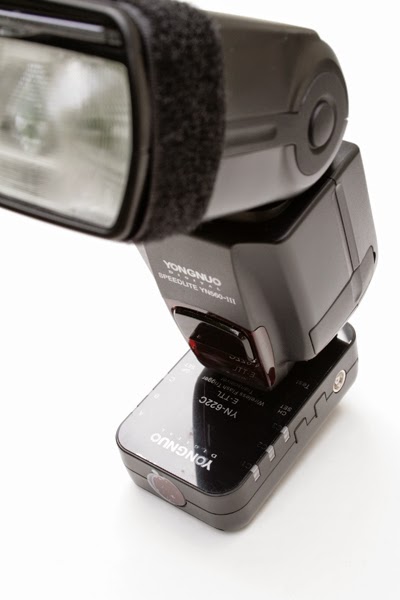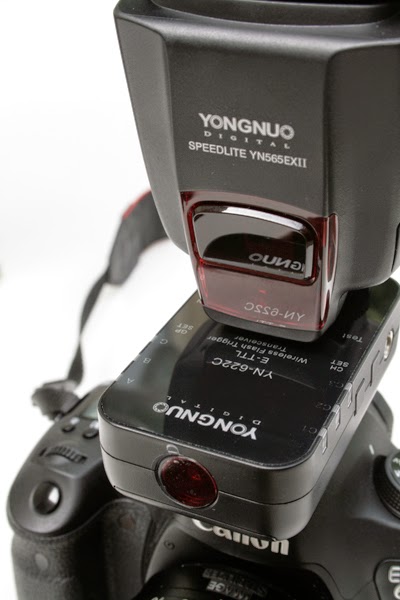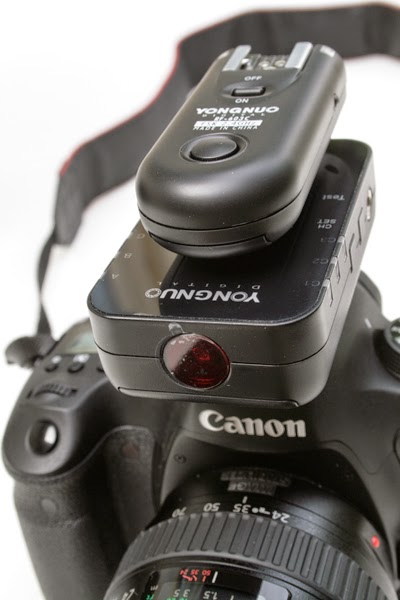Speedlites , simply stated, are accessory flashes that attach to the hot shoe of your DSLR. By raising the light source above the camera, the speedlite produces a more pleasing effect than the harsh head-on shadow cast by the camera’s built-in popup flash.
But there’s more to speedlites than that. Most have swivel heads that allow you to “bounce” the flash off a ceiling or wall to provide a more diffuse light source. This has the effect of softening the shadows behind the subject and more evenly filling in shadow areas on the face. Because the flash head is now well separated from the camera body, you can also add light modifiers such as a collapsible softbox. As the name implies, it softens or diffuses the light, allowing you to aim the speedlite directly at the subject rather than depending on a bounce surface. Outdoors in daylight, these are often used as a “fill” light to overcome the harsh shadows cast on the face by mid-day sunlight.
Better yet, speedlites have their own internal battery supply, so they can be separated from the camera and used in the same way as studio strobes. By mounting them on light stands and firing them with inexpensive radio triggers, you can have studio lighting anywhere, without the need for AC power. Add lightweight bounce umbrellas to diffuse the light evenly, and you can have as many light sources as you like filling an area with even, soft light.
So how do you configure this portable studio? Most of the small stuff can be bought on eBay much cheaper than at local retailers, but bulky items like light stands and umbrellas, in my humble opinion, can be sourced locally for not much more than overseas online pricing. And you have the benefit of not having to wait 2-3 weeks for product.
When it comes to speedlites and radio triggers, however, I would like to make a recommendation. While I want to stress that I have no affiliation with the company, I have found products made by Yongnuo of China to be well made and very cost effective. Just be sure that when you make a purchase that the models you choose are designed for your specific DSLR model. In some cases, their triggers are also compatible with camera manufacturers’ speedlites, but why not buy a speedlite that works as well at a third of the price?
So what is a radio trigger? If you decide to use a speedlite off-camera, you will need a means of making the flash fire when you press the camera’s shutter button. The transmitter mounts on your camera’s hot shoe and sends a signal to the receiver, which you mount on the light stand. The receiver has a hot shoe built onto it, so you simply attach your speedlite to it. Some triggers, like the YN-603, are actually transceivers, so you can use them as either a transmitter (when mounted on the camera’s hot shoe), or a receiver (when the speedlite is attached to it).
Now, there are two types of speedlites that you should be aware of: manual (such as the YN-560 III) or full ETTL (such as the YN-565 EXII). ETTL stands for Evaluative Through The Lens, meaning the camera and speedlite work together through connections on the hot shoe to ensure that the light output from the speedlite gives optimal exposure.
 |
| YN-560 III in off-camera configuration |
A manual speedlite, however, requires that you set the light output on the speedlite itself by either trial-and-error or by using a flash meter. Studio setups are typically all manual. The YN-560 III has a very nice feature: built in radio receivers that are compatible with the YN-603 trigger. This means that you only need a single YN-603 on the camera’s hot shoe, rather than also attaching one to each of the speedlites to act as receivers. One feature of a manual flash is that its hot shoe connection is comprised of only a single contact point. This makes it compatible with a wide range of cameras, as opposed to an ETTL speedlite that has an arrangement of multiple contacts that are specific to a camera brand. This is why you must buy an ETTL speedlite specifically for your camera.
Yongnuo also makes an ETTL radio trigger called the YN-622. Two of these transceivers will allow you to trigger a compatible off-camera ETTL speedlite like the YN-565 EXII in full ETTL mode, meaning you don’t have to manually set the speedlite output. The camera reads the light from the speedlite through its lens and sends commands to the speedlite over the YN-622 radio link to adjust its output. You can also control groups of speedlites with these so that each has a different output level, but still controlled by the camera.
 |
| YN-565 EXII operating ETTL through a YN-622 |
Another benefit of using the YN-622 and a compatible speedlite on the camera is that you can use that speedlite in ETTL mode while simultaneously triggering a manual flash with a second YN-622 off-camera. That way, you can quickly move from a studio setup with two lights to a roaming subject using the single ETTL speedlite on your camera (such as in a wedding reception). The YN-622 simply attaches to the camera’s hot shoe and the speedlite attaches to the YN-622’s hot shoe.
 |
| Stacked YN-603 on a YN-622 |
While the Yongnuo product line is great value for money, however, I get the sense that the company doesn’t have a uniform design vision. For example, the built-in trigger receiver in the YN-560 III doesn’t exist in the YN-565 EXII. Where this becomes an issue is if you want to use the 560 and 565 together in a setup (with the 565 set to manual mode) and trigger them both from a single YN-603 trigger on the camera. Also, you can’t mix and match YN-603 and YN-622’s in a setup because they’re not compatible. You can, however, stack one on top of the other on your camera’s hot shoe and have each trigger their respective receivers.
By doing a little research, you can configure a professional lighting setup for well under $500. Just be sure that you are buying product that is 100% compatible with your camera make and model
USING SPEEDLITES FOR IMPROVED RESULTS
Fatal error: Out of memory (allocated 205180928) (tried to allocate 31457464 bytes) in /hermes/bosnacweb08/bosnacweb08ac/b1393/nf.realworldphoto/public_html/filmscapes.ca/wp-includes/class-walker-comment.php on line 180